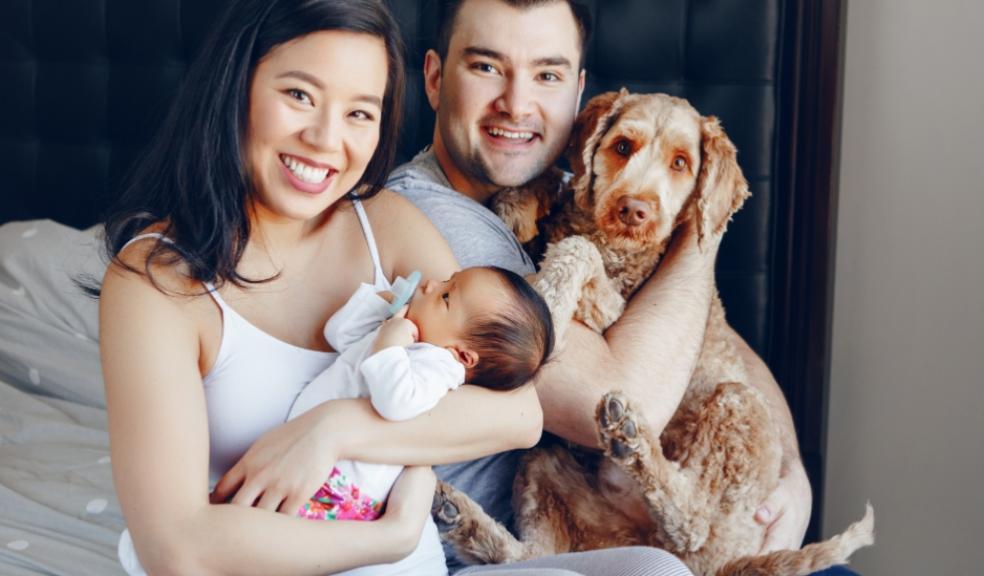
How to introduce your dog to a new baby
Bringing a new baby into the family is a time for celebration! However, when you have a furry friend at home, it's crucial to ensure a smooth transition for everyone’s well-being and safety. Pooch & Mutt provide expert advice on introducing your dog to your new baby.
Before the baby arrives:
1. Make them part of the pregnancy: Dogs are intuitive and will notice changes in your body and scent due to hormonal shifts. They may react differently - some becoming clingy, others territorial. Make them feel involved in your pregnancy journey while setting boundaries for long-term harmony.
2. Training: Ensure your dog knows basic commands like ‘no’, ‘stay’, and ‘leave’ to maintain control when the baby arrives. Set up the nursery a few months in advance, and teach your dog not to touch the baby’s things or enter unless they’re invited.
3. Gradual routine changes: Gradually adjust your dog's routine before the baby arrives to reduce stress. Start walking them with the pram to familiarise them with it and establish walking boundaries. You can also feed your dog in a different room or increase outdoor playtime based on your future plans.
4. Familiarise with new sounds and smells: Crying, breast pump noises, baby lotions and potions. Introduce your dog to baby-related sounds and smells to reduce anxiety.
Introducing your dog to your baby
1. Scent introduction: Once your baby arrives, introduce a blanket or piece of clothing with their scent to your dog. This helps familiarise them with the baby’s smell beforehand, reducing their curiosity during introductions and easing your concerns.
2. Exercise: A tired pooch is usually a less boisterous one. Take your dog for a walk to release excess energy before the introduction.
3. Leash control: Keep your dog on a leash during the initial meeting to maintain control and ensure safety. This approach prevents territorial behaviour and helps your dog recognise the baby as part of a household.
4. Gentle sniffing: Allow your dog to sniff the baby from a distance while rewarding calm behaviour. If they won’t calm down, take them into another room and distract them until they’re calmer. Then try again. Try not to get angry – as this will become a negative association with the baby.
5. Don’t push your pooch out: Life with a new baby can be hectic! Remember it’s a big adjustment for your dog too. Continue bonding activities with your pooch and be patient during the introduction process.
6. Feed some calming products: To help your pooch stay more chilled during introductions and beyond, it could be a good idea to feed them some calming foods, treats or supplements beforehand.
7. Supervision: Always supervise interactions between your dog and baby to ensure safety.
Understanding your dog’s behaviour:
1. Growling at the baby: Address fear, jealousy, or possessiveness calmly and don’t get angry. Shouting at your dog will only cause them more stress, which could cause them to bite. Always keep them under supervision, use learnt commands, move them into a space that feels safe for them, reward good behaviour, build up further introductions at a slow pace and if it continues, then contact a behaviourist straight away.
2. Stress from baby crying: Create a safe space for your dog to retreat to when distressed by baby cries, this could be their own room or cosy crate area if they’re crate-trained.
3. Licking: Your dog may lick your baby out of instinct or to show affection. However, it could also be a sign of dominance, posing a safety risk. Additionally, dog saliva can pose a risk to babies with weaker immune systems. Promptly address this behaviour and reward calm interactions near the baby with treats.
Signs of potential aggression:
Dogs usually attack because of fear. Watch out for subtle signs such as yawning, lip licking, trembling, crouching, ears down, tail tucking, whale eye (showing whites of their eyes) or tensing and not moving. If you notice any of these signs, then immediately take your dog into their safe space away from your baby.
Pooch & Mutt Dog Behaviourist, Dr Emma Scales-Theobald adds: ‘Bringing a new baby into the family is an exciting time but can be unsettling for our dogs. There are things we can do to help prepare them for this big change and help them feel comfortable once the baby arrives. It is important to keep an eye on our dogs and watch for behaviours that indicate how they are feeling. Allow your dog to adapt to these changes slowly, at their pace, and always make safety and supervision a priority. With space, patience and positive reinforcement, your fur baby will develop a lasting heart-warming bond with your baby’.
By following these steps and monitoring your dog’s behaviour, you can ensure a smooth and positive transition for both your dog and your new baby.







